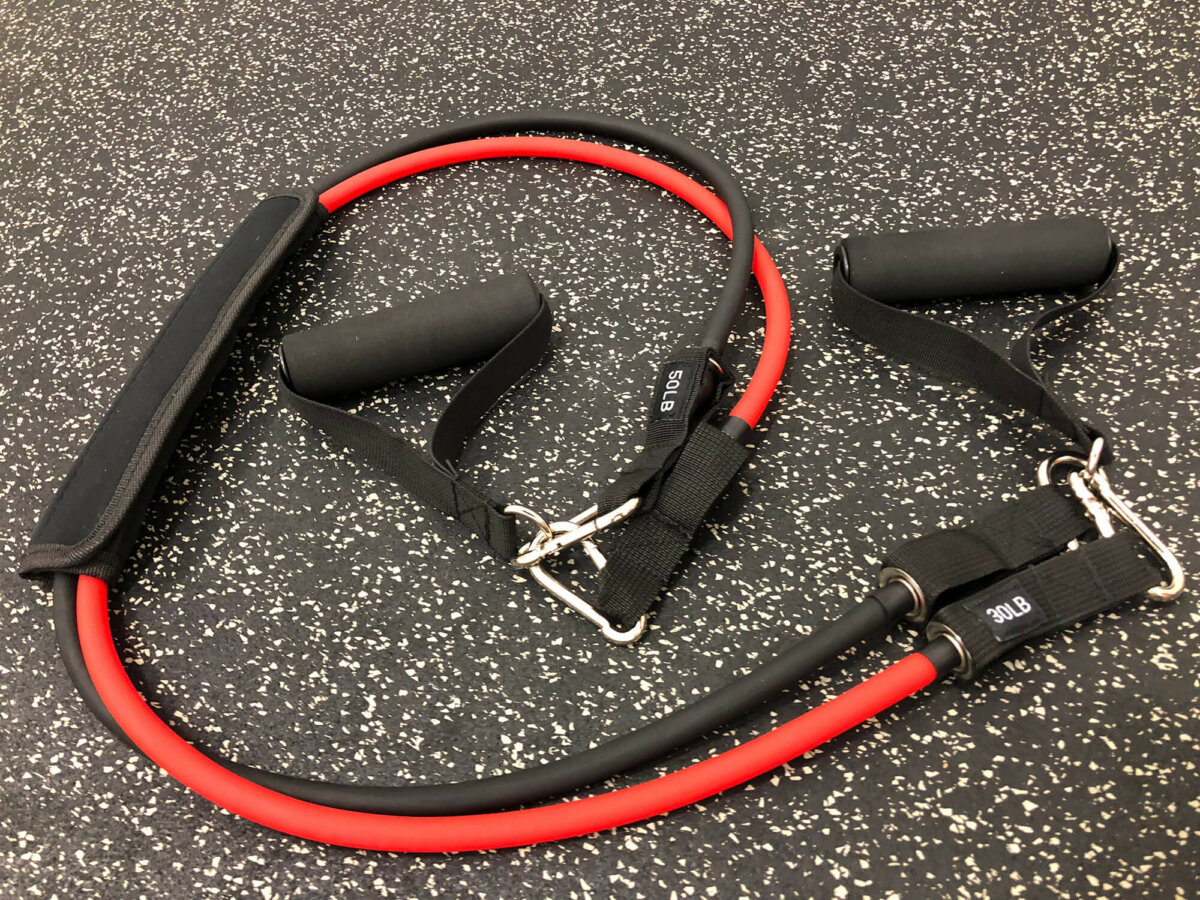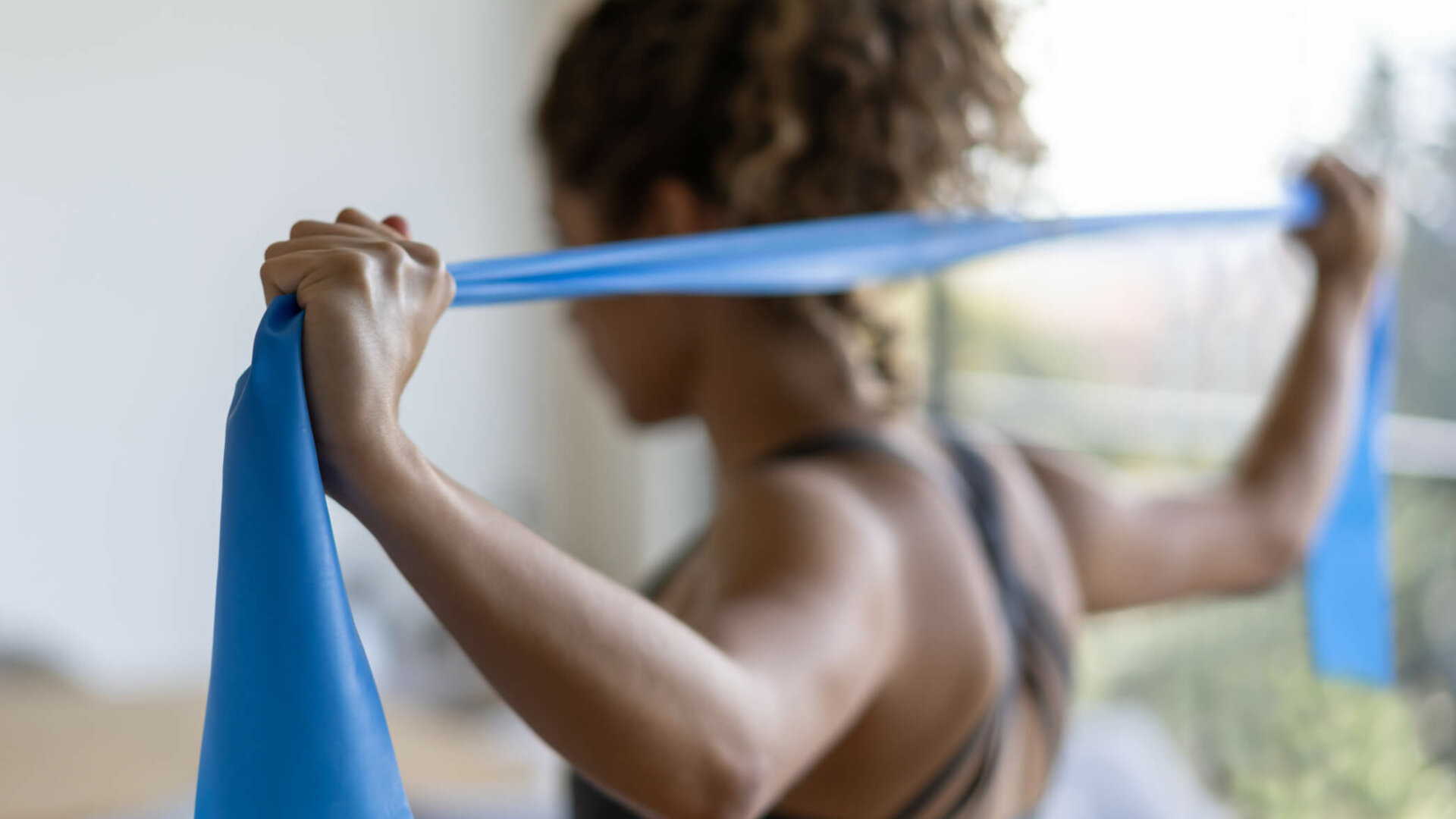Right up there with Jazzercising and Pilates, resistance bands tend to be considered pretty laughable as a training option for serious physique athletes. As a whole, focusing on free weights and machines that allow for continued, significant progressive overload is certainly the way to go for anyone serious about long-term physique development. However, in the past year, I’ve grown to appreciate the benefits that resistance band training can have as a part of the bigger physique development equation.
Opportunities to travel, mixed with stretches of time where maximizing my time in the office was important to complete various projects, has led me to get a bit more creative with back-up plans for occasions where making it to the gym might be out of the question. A quality set of resistance bands may be an unexpectedly valid back up plan to maintain workout consistency when schedules get crazy, even for the serious lifter focused on muscle growth.
Below is an article focused on important considerations and strategies that can make resistance band training a viable option in a pinch, while helping to still provide a relatively solid workout you can achieve virtually anywhere.

Ideal Uses for Resistance Bands
As mentioned above, resistance bands can be helpful, but only in certain situations. Although resistance bands (RBs for the sake of brevity in this article) tend to get a bad rap from experienced athletes, the major drawback from them is arguably not so much in their use, but in their overuse. It’s possible to get a solid workout through a variety of methods. It’s just important to realize what’s most optimal in our long-term approach to our physique goals. Trying to use RBs as a substitute for our normal free weight and machine-based training programs is a sure way to greatly limit progress, but using them in a pinch can be a lot more helpful than completely skipping our workouts when times get busy.
That preface out of the way, there are some situations we’ll likely all face at some point or another, when having a quality set of RBs along with a plan to most effectively use them, can be a lifesaver… well more like a gainz saver.
Traveling
Now yes, if you’re traveling, the ideal situation would be to visit local gyms, pay a guest pass and get in at least a few of your normal sessions each week you’re away. However, sometimes visiting local gyms isn’t an option. Whether it’s because you’re on a huge vacation you want to make the most of, are looking to minimize unrealistically high guest pass fees, or business trips don’t allow for sufficient time to visit gyms, RBs can help fill in the gaps.
Work Obligations
All or nothing mindsets have ruined many a person’s long-term health and physique progress. Although not ideal, missing gym sessions for the sake of work obligations happens. The danger isn’t the occasionally missed session, but the habit that skipping sessions can create if we’re not careful. Having a quality set of RBs on hand, along with a backup routine in mind, can go a long way in at least keeping us in the groove and making some progress rather than completely forsaking workouts and making no progress at all.
Deloads & Injuries
Although most deload phases can be completely taken care of with typical resistance training equipment, let’s face it- some deload workouts feel almost like a waste of time even driving to the gym for (although they’re very beneficial). Especially with upper body deload sessions, bodyweight and RB workouts at home can be a quality option. Even if training at the gym during a deload, they can be a nice, low impact way to get some volume in while you’re recharging prior to your next training block.
My Blood Flow Restriction for Beginners article outlines what exactly BFR is and how to best incorporate it for those interested in learning more. In short, BFR allows athletes to use relatively light loads to maintain muscle tissue during periods of time where normal loading isn’t possible or ideal, most often due to injury.
Either in conjunction with BFR cuffs, or separately, resistance bands can be helpful in getting some solid training volume in through relatively low intensity, high repetition workouts. This is pretty easy to believe considering their popularity among physical therapists and various rehab settings. Especially if your injury either limits you from traveling to your gym, or just leaves you less than excited to navigate a busy gym while all banged up, having some quality RBs on hand can be a helpful remedy in the meantime.
The Cons
So we’ve established that sometimes, having RBs as a backup plan can be helpful. That being said, it’s not enough to just say, “Use resistance bands when time is limited” and call it a day. RBs do have some downsides that we want to accommodate for as best we can to help get the most of the sessions.
Minimal Eccentric Resistance
One major drawback I find is the lack of eccentric tension when using RBs. It’s easy to focus on the concentric (lifting) portion of banded exercises, then just let gravity take it during the eccentric portion(lowering). Considering resistance bands are already more challenging to create sufficient and progressive intensity with, making a point to really maximize that eccentric phase with a slow, controlled return from peak contraction can help at least minimize that gap in effectiveness.
Accommodating Resistance
Related in part to the above mention of the eccentric phase, another drawback is just the accommodating resistance in general that accompanies RB use. Similar to the principle of using chains attached to barbells, resistance bands are going to offer the most resistance at the end of each rep, and much less near the beginning. That of course means more total work being performed in some lever angles than others. Keeping this in mind when adjusting your total resistance and implementing considerations covered later in this article can help navigate around these issues to create sufficient, total work during RB exercises.
The Pros
As you’ve already gathered on your own and in this article, the main plus to using resistance bands is just the time they can save when unable to reach the gym, and their ability to help us get some workouts in even if we can’t accomplish our typical, ideal workouts.
This section is short, and for good reason. RBs can be great for a back up plan, but should certainly never be confused as being just as good as traditional weight lifting. Anyone serious about long-term, significant physique development is going to require otherwise consistent time spent performing traditional weight lifting, getting progressively stronger, and performing a variety of foundational movement patterns to optimize strength and muscle size improvements.
Upper Body Considerations
I’m listing considerations specific to upper body training with RBs since, as you’ll see later in this article, I believe lower body training requires quite a different approach. When it comes to RBs, upper body training can be a bit easier to get creative with and find exercises to train most muscle groups.
High Repetitions
It almost goes without saying, but going very heavy with resistance bands is pretty darn difficult. Due to the general instability bands have compared to free weights or machines, and to the limitations in resistance on the bands themselves (even when combined with other bands), it’s just much easier and productive to focus on higher rep sets.
Just like adding in some high rep sets in our traditional weight lifting sessions can give us a break from our very heavy, taxing sets and help stimulate muscle fibers through a different avenue, having to use high reps with RB sessions isn’t necessarily something to begrudge. Running sets of anywhere from 10-30+ reps can be a valid approach to making your RB sessions challenging.
Contraction Time
Between the accommodating resistance mentioned previously, and the reduced ability to progressively go heavier with RBs, playing with the contraction duration can be a helpful intensity technique to keep in mind. Compared to our typical ~1 second squeeze at the top of a bicep curl for example, increasing that squeeze to 2-4 seconds can increase intensity. One bright side I like to consider during sessions I’m using RBs is that I can really focus on squeezing the target muscle and improving my ability to really activate the muscle to full contraction. Basically, working in different contraction durations can at least help us with that mind muscle connection even if we aren’t lifting heavy weight, as we would prefer.
Volume over Variety
Even the most creative individuals are going to have a hard time thinking of exercises that actually provide a sufficient stimulus through resistance bands. For that reason, it’s typically better to find exercises that work and focus on getting volume through them, rather than trying to go crazy with variety just to try and train through different angles. Find a couple exercises for each body part that work well, and then just hammer away with those to keep things simple and allow for more streamlined progression.
Don’t Forget Bodyweight Exercises
Just because you’re focused on implementing RB work, doesn’t mean you should forget about the classic bodyweight exercises that can really come in handy when stuck at home or away traveling, given the minimal need for equipment or space. Complimenting your RB work with some tried and true bodyweight work like the exercises listed below can make for a pretty solid workout.
- Dips
- Push Up Variations
- Pull Up Variations
- Hanging Knee Raise Variations
- Floor-Based Ab Work (crunches, bicycles, Russian twists, etc.)
- Bulgarian Split Squats
- Single Leg Hip Thrusts
- Glute Bridge Variations
- Standing Calf Raises
- Pistol Squats
Leg Training Considerations
If there’s ever any major exception to my suggestions on using RBs in place of searching for and paying guest passes to gyms when traveling, it’s leg training. With upper body sessions, it can be much easier to get creative with bodyweight and RB exercises and still create sufficient intensity. Leg training however, I would argue is quite a bit more difficult.
Sure, you can do some bodyweight squat and lunge variations, and you can actually create a pretty good glute workout with not much more than your own bodyweight. However, aside from a nice booty burn, achieving sufficient intensity in banded or bodyweight leg exercises is going to be pretty darn difficult.
If you have a door anchor (which many RB sets come with), then doing some leg exercises can be possible: namely, things like band kickbacks, abductor work, and a few other miscellaneous movements. As a whole though, doing anything really productive is going to be nearly impossible for athletes with virtually any experience. RBs can be great for maintaining upper body training, but if at all possible, I would suggest just making the time and paying the guest pass to at least get your leg sessions in each week whenever away on vacation or business trips.
Coming from quite the frugal man when it comes to unnecessary expenses, this is one time where I would say it’s certainly worth the $10-20 day pass investment to take care of leg training, even when on vacation or business trips. Save time and money with your upper sessions if need be, then make the investment to continue getting quality leg sessions whenever possible.
Purchase Considerations
At the risk of sounding pedantic, as simple as buying resistance bands is, there are a few considerations I want to mention that can help you get the most out of your set. A few small features can pretty considerably expand the exercises, and level of progression with those exercises, athletes can take advantage of.
Door anchor
Especially if you’re purchasing a RB set, keep an eye out for one that includes a door anchor. Being able to anchor your bands to the door, while being protected against door damage, can greatly increase the total exercises that can be performed. Movements like tricep extensions, back rows, rear delt flyes, face pulls, and some glute movements can be performed with the help of a door anchor.
Carabiners
I would definitely make sure to purchase a set that has carabiners you can use to attach multiple resistance bands to a single handle, which make it much easier to increase total resistance. In contrast, using resistance bands that have fixed handles attached make it much harder to incrementally increase resistance.
Friction Pad
Some sets will come with a small Velcro pad you can wrap around your bands to reduce friction from your feet, the ground, or whatever they’re anchored to while you’re using them. Even if your set doesn’t include one, just using a small towel can help reduce wear and tear so you aren’t left buying new sets constantly, or worse yet- one breaks and slaps you mid-set!
Resistance Band Exercise Ideas
Chest
Although it’s technically possible to do some pressing and fly variations with the use of a door anchor, it’s not likely worth the set up time. For chest, I would suggest focusing on push up and dip variations using your own bodyweight to achieve sufficient training intensity.
Back
Back is a bit easier to train with resistance bands. With a door anchor on hand, some rows and reverse fly variations can be performed relatively effectively.
- Bent Over Rows
- Bent Over Rear Delt Flies
- Kneeling High Rows (w/ door anchor)
- Kneeling Face Pulls (w/ door anchor)
- Kneeling Horizontal Row (using pole, tree, etc. as an anchor)
Shoulders
- Standing Shoulder Press
– I find these best to perform with the band and handle toward the front, rather than behind the arms, for a smoother execution and feel - Standing Lateral Raises
- Standing Front Raises
- Band Pull Apart
Biceps
- Standing Bicep Curls
- Standing Hammer Curls
- Behind the Back Bicep Curls (w/ low door anchor)
Triceps
This is a muscle group that will be very dependent on whether you have a door anchor or not. Being able to anchor the band above you will allow for some solid tricep extension variations.
- Tricep Kickbacks
- Standing Overhead Tricep Extensions
- Tricep “Rope” Extensions (w/ door anchor)
- Overhead Tricep Extensions (w/ door anchor)
I can’t promise anyone a world-class workout from the comfort of their hotel room or bedroom. However, when it comes to finding solutions to days we would otherwise miss a workout entirely, a strategic incorporation of resistance bands and classic bodyweight exercises can help fill that void, and keep us headed in the right direction of our physique goals.

